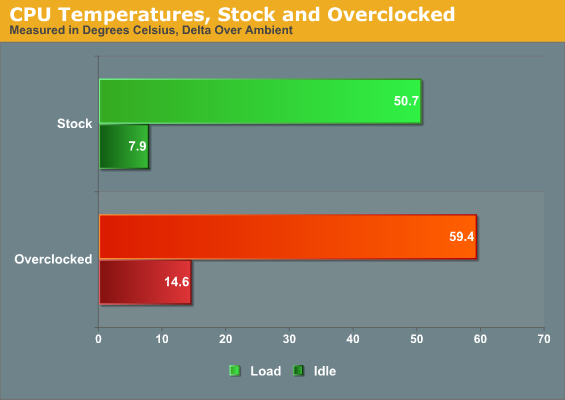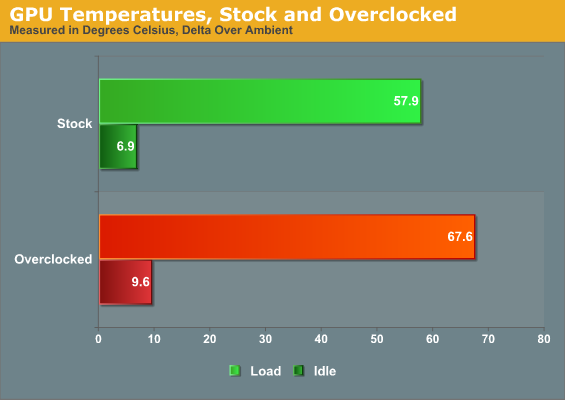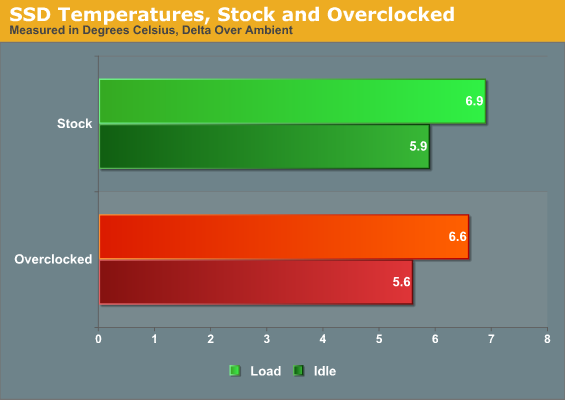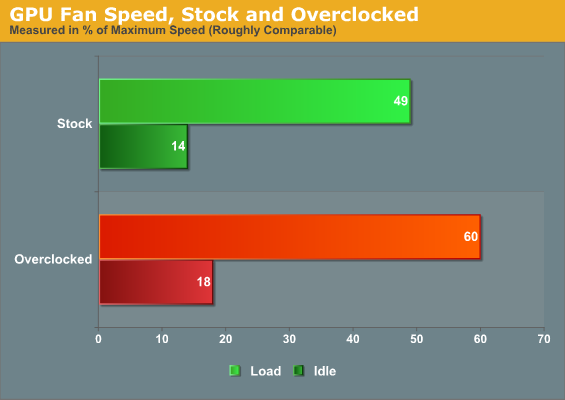Corsair Obsidian 550D: Starting to Specialize
by Dustin Sklavos on March 29, 2012 3:01 PM EST- Posted in
- Cases/Cooling/PSUs
- Corsair
- mid-tower
Noise and Thermal Testing
Since we currently only have test results for the Corsair Obsidian 550D based on our new testbed and methodology, this is going to be a relatively short breakdown. Still, there's useful information to be had.



Under the new testing rubric it can be a little difficult to figure out what's going on. First, we can see the CPU and GPU both get about a 10C increase in temperature when overclocked in the Obsidian 550D, while idle temperature increases are nowhere near as severe. The ambient temperature when testing was ~22C, which would result in absolute thermals in the 80s for the CPU...not the greatest results but not dangerous either. GPU thermals are at the 90C threshold, but when you see our fan speed results you'll see the GTX 560 Ti still has some headroom before actually overheating. Meanwhile, the SSD temperatures are within the margin of error; the increased stress from the CPU and GPU in the overclocked configuration doesn't impact the SSD in any noteworthy way.


While thermal performance isn't horrible, the fans definitely had to work reasonably hard to keep things under control. The Hyper 212 Evo's fan is virtually maxed out by the thermal load; in practical terms, the 550D in its stock configuration just doesn't seem to have that much of a ceiling for CPU overclocking. Meanwhile, the 560 Ti's fan speed gets a substantial enough jump to prove noticeable, but end users who demand more power will likely meet the limitations of the silicon itself before they hit the limits of the cooling system.

Since 30dB is the floor for our sound meter, we can safely say the Corsair Obsidian 550D is able to keep things under control while the system is idling, regardless of whether or not the components are overclocked. Under load the 550D remains very quiet; in a silent room the difference is noticeable, but in practical use it's far less likely. Unfortunately, when overclocked the 550D has a harder time keeping the noise down; the high pitch of the GTX 560 Ti's fan, in particular, makes itself known.










59 Comments
View All Comments
SilthDraeth - Thursday, March 29, 2012 - link
Actually, in following up, I express my ignorance for not reading the review first. It appears they built a standardized test bed for cases, and this is the first case to be tested with the new test bed.Also, going on the assumption that review hardware doesn't sit around indefinitely, I would gather that future case reviews will be done with the standard test, as I mentioned in my above post.
haelio - Thursday, March 29, 2012 - link
I'm sure there must have been more than this case around in Anandtech HQ :) Adding even one other case for comparison would improve this review immensely.I hope this review's graphs are updated when other cases are used with this test bed.
JarredWalton - Thursday, March 29, 2012 - link
"AnandTech HQ" is where each of us happens to live; I'm in WA, Dustin's in CA, Anand is in NC, Ryan is in OR, Johan is in Belgium, and Brian is in AZ, just to name a few. I'm sure Dustin does have more than one case at his home/apartment, but going back to "re-review" some cases means he basically doubles (triples) the workload for an article just for the sake of graphs. The next review should have two cases listed, and once we have half a dozen or so reviewed this won't be much of a problem.Just for the record, we originally tried to come up with a good testbed so that we wouldn't have to change it after just one year, but first attempts sometimes fall short. So now we have a new testbed that should last Dustin several more years. :-)
MrMaestro - Friday, March 30, 2012 - link
That's fair enough, Jarred, it's just that the next case review probably aren't going to be all that relevant. I don't really care how this case compares to your average value or gaming case, I want to know how it compares to its competition - the Antec SOLO II, Fractal Define R3, Cooler Master Silencio and the Silverstone FT02, to name a few. Dustin even mentions that the FT02 is better in the conclusion. Ok, it's not direct competition, since the FT02 is $100 more expensive, but I would like to know if that $100 is worth it.I guess I'm a little disappointed because I'm tossing up quiet cases for my next build, and this review just isn't all that helpful to me. I don't mean to bitch and moan, as the writers such as yourself are doing a great job, and I get to enjoy it for nothing. I also don't envy Dustin's job of repeatedly building and tearing down systems for case reviews. I was looking forward to this review and it was a little disappointing is all.
Cheers.
Dustin Sklavos - Friday, March 30, 2012 - link
You can draw a rough comparison between the stats for this enclosure and our previous reviews by adding ~23C to the thermals. Noise levels aren't so fortunate.The reason I suggest the FT02 as a superior option is because I'm actually using an FT02 for my personal desktop. Overclocked i7-990X and two GTX 580s sandwiched together in SLI; with an aftermarket fan controller, the FT02 is actually able to keep all of that both cool and remarkably silent under load. Subjectively, the FT02 is a hair louder at idle than the 550D, but DEFINITELY quieter under load.
mtoma - Friday, March 30, 2012 - link
Disappointment I wouldn't call it: after all it is tested a new model of quiet computer case (and the enthusiasts know they aren't to many models to chose from).The fact that we don't have any reference to say ... Antec P280, is unfortunate, but let's not forget that vibration problems are important too (not only noise and thermals), and if there is a chance that to occur in Corsair.... I'm sorry.
Not last, we should remember that changing the testing methodology is a good thing, is a progress. We shouldn't blame progress, and we shouldn't blame a reviewer before reading an article.
kevith - Saturday, March 31, 2012 - link
Hi Jarred.Would it be possible to do a sort of "here-we-are" article on the structure and people of Anandtech?
We all check in almost every day to read the articles by the well-known signatures, but we don't know how you look - apart from Anand - we don know what your "labs" look like, where you're located or how you coordinate the "mag" etc. etc.
Will you share that with us?
gordo453 - Thursday, March 29, 2012 - link
on the top of the second page you say 500D instead of 550D8steve8 - Thursday, March 29, 2012 - link
full size ATX cases seem utterly irrelevent now days...I love anandtech, but i wish they spent more of their case-reviewing energy on smaller, more modern designs.
with mobos like the Asus Z77-I Deluxe for those who can make due with 2 dimm slots, and countless high end micro atx mobos with no relevent concessions for their smaller size, i find it dubious to think full size ATX is required outside of very rare cases where you need a large number of pcie cards.
JCheng - Thursday, March 29, 2012 - link
If Amazon's "Most Popular" sorting is any indication, full size ATX is alive and well, as 16 of the top 20 cases are ATX or bigger.